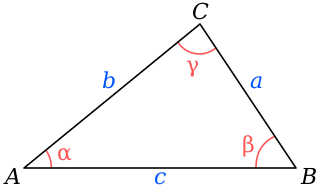Video module descriptions
A total of nine educational video modules were created between 1988 and 2000. Another two modules, Teachers Workshop and Project MATHEMATICS! Contest, were created in 1991 for teachers and are only available on videotape. The content of the nine educational modules follows below.
The Theorem of Pythagoras

In 1988, The Theorem of Pythagoras was the first video produced by the series and reviews the Pythagorean theorem. [4] For all right triangles, the square of the hypotenuse is equal to the sum of the squares of the other two sides (a2 + b2 = c2). The theorem is named after Pythagoras of ancient Greece. Pythagorean triples occur when all three sides of a right triangle are integers such as a = 3, b = 4 and c = 5. A clay tablet shows that the Babylonians knew of Pythagorean triples 1200 years before Pythagoras, but nobody knows if they knew the more-general Pythagorean theorem. The Chinese proof uses four similar triangles to prove the theorem.
Today, we know of the Pythagorean theorem because of Euclid's Elements, a set of 13 books on mathematics—from around 300 BCE—and the knowledge it contained has been used for more than 2000 years. Euclid's proof is described in book 1, proposition 47 and uses the idea of equal areas along with shearing and rotating triangles. In the dissection proof, the square of the hypotenuse is cut into pieces to fit into the other two squares. Proposition 31 in book 6 of Euclid's Elements describes the similarity proof, which states that the squares of each side can be replaced by shapes that are similar to each other and the proof still works.
The Story of Pi

The second module created was The Story of Pi, in 1989, and describes the mathematical constant pi and its history. [5] The first letter in the Greek word for "perimeter" (περίμετρος) is π, known in English as "pi". Pi is the ratio of a circle's circumference to its diameter and is roughly equal to 3.14159. The circumference of a circle is and its area is . The volume and surface area of a cylinder, cone sphere and torus are calculated using pi. Pi is also used in calculating planetary orbit times, gaussian curves and alternating current. In calculus, there are infinite series that involve pi and pi is used in trigonometry. Ancient cultures used different approximations for pi. The Babylonian's used and the Egyptians used .
Pi is a fundamental constant of nature. Archimedes discovered that the area of the circle equals the square of its radius times pi. Archimedes was the first to accurately calculate pi by using polygons with 96 sides both inside and outside a circle then measuring the line segments and finding that pi was between and . A Chinese calculation used polygons with 3,000 sides and calculated pi accurately to five decimal places. The Chinese also found that was an accurate estimate of pi to within 6 decimal places and was the most accurate estimate for 1,000 years until arabic numerals were used for arithmetic.
By the end of the 19th century, formulas were discovered to calculate pi without the need for geometric diagrams. These formulas used infinite series and trigonometric functions to calculate pi to hundreds of decimal places. Computers were used in the 20th century to calculate pi and its value was known to one billion decimals places by 1989. One reason to accurately calculate pi is to test the performance of computers. Another reason is to determine if pi is a specific fraction, which is a ratio of two integers called a rational number that has a repeating pattern of digits when expressed in decimal form. In the 18th century, Johann Lambert found that pi cannot be a ratio and is therefore an irrational number. Pi shows up in many areas having no obvious connection to circles. For example; the fraction of points on a lattice viewable from an origin point is equal to .
Similarity
Discusses how scaling objects does not change their shape and how angles stay the same. Also shows how ratios change for perimeters, areas and volumes. [6]
Sines and Cosines, Part I (Waves)
Visually depicts how sines and cosines are related to waves and a unit circle. Also reviews their relationship to the ratios of side lengths of right triangles.
Sines and Cosines, Part II (Trigonometry)
Explains the law of sines and cosines how they relate to sides and angles of a triangle. The module also gives some real life examples of their use. [7]
Sines and Cosines, Part III (Addition formulas)
Describes the addition formulas of sines and cosines and discusses the history of Ptolemy's Almagest. It also goes into details of Ptolemy's Theorem. Animation shows how sines and cosines relate to harmonic motion.
Polynomials
How polynomials can approximate sines and cosines. Includes information about cubic splines in design engineering. [8]
The Tunnel of Samos
How did the ancients dig the Tunnel of Samos from two opposite sides of a mountain in 500 BCE? And how were they able to meet under the mountain? Maybe they used geometry and trigonometry. [9] [10]
Early History of Mathematics
Reviews some of the major developments in mathematical history.
















